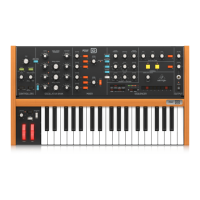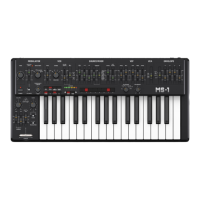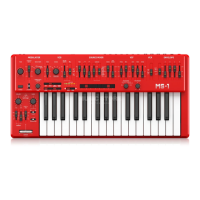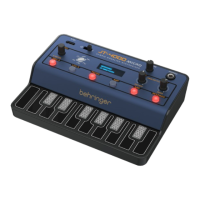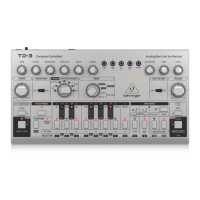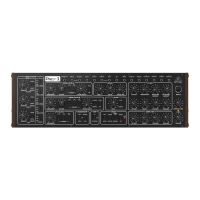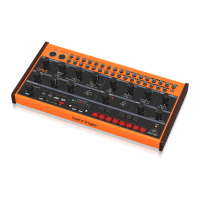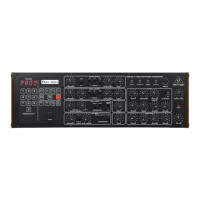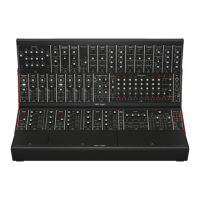10 MODEL D User Manual
3.1.5 Modiers Section
(30) DECAY - when ON, the signal will decay during the time set by the DECAY
TIME knob after a note or external trigger is released. When OFF, it will
decay immediately after a note or external trigger is released.
LOUDNESS DECAY - aects the decay of volume level of the Loudness
section.
FILTER DECAY - aects the decay of the cuto frequency of the Filter
section.
(31) KEYBOARD CONTROL - these switches vary the eect of the keyboard
tracking, where the lter section is aected by the pitch of note played.
Switch 1 and 2 OFF - no keyboard tracking eect
Switch 1 and 2 ON - maximum eect
Switch 1 ON (only) - 1⁄3 of maximum eect
Switch 2 ON (only) - 2⁄3 of maximum eect
(32) FILTER MODULATION - when ON, the lter section is modulated by the
modulation mix, set by the MOD MIX knob.
(33) FILTER MODE - select the lter between Low-Pass or High-Pass.
(34) LOUDNESS CONTOUR - these 3 knobs adjust the overall shape enveloping
the audio after it has passed through the mixer section and lter section.
The controls aect the change in volume (loudness) level with time.
ATTACK - adjust the time it takes for the signal to reach a maximum
level after a note is played.
DECAY TIME - adjust the time for a signal to decay down to the sustain
volume level after the attack time is over. If the LOUDNESS DECAY switch
is ON, this is also how long it takes to decay to minimum once a note is
released.
SUSTAIN - adjust the volume level that the signal is sustained after the
attack time and initial decay time have been reached.
(4)
(2) (3) (17)
(10) (11) (12) (13) (14) (15) (16) (20) (21) (22)
(24)
(25)
(23)
(18) (26) (27)
(35) FILTER ENVELOPE CONTROLS - these 3 knobs adjust the overall shape
enveloping the lter section. The controls aect the change in cuto
frequency with time.
ATTACK - adjust the time for the cuto frequency to increase from its
set value and reach the frequency set by the AMOUNT OF CONTOUR
control.
DECAY TIME - adjust the time for the cuto frequency to decay down to
the sustain frequency after the attack time is over. If the FILTER DECAY
switch is ON, then this decay time is also how long it takes to decay from
the sustain frequency once a note is released.
SUSTAIN - adjust the cuto to a frequency which is sustained after the
attack time and initial decay time have been reached.
(36) FILTER CONTROLS - the lter can be Low-Pass or High-Pass, depending
on the setting of the FILTER MODE switch. In Low-Pass mode, audio
frequencies above the cuto frequency are attenuated. In High-Pass mode,
audio frequencies below the cuto frequency are attenuated.
CUTOFF FREQUENCY - adjust the cut-o frequency of the lter.
FILTER EMPHASIS - adjust the amount of volume level boost
(resonance) given at the cut-o frequency.
AMOUNT OF CONTOUR - adjust the amount of frequency shift given to
the cuto frequency.
(37) CUT CV (INPUT) - allows connection of a control voltage to control the
cuto frequency.
(38) FC GATE (INPUT) - allows an external trigger voltage to be applied to
trigger the lter contour.
(39) FILT CONT (OUTPUT) - outputs the lter contour.
(40) LC GATE (INPUT) - allows an external trigger voltage to be applied to
trigger the loudness contour.
(41) LOUD CONTOUR (OUTPUT) - outputs the loudness contour.

